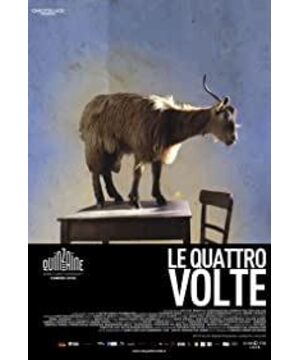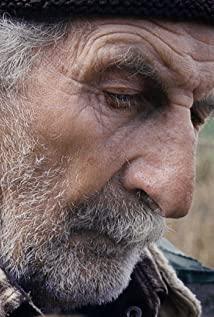Michelangelo Fran Martino's film "Four Times" is a transcendent "silent film": a completely restrained silence, the entire film has no language.
If it's just a no-dialogue movie, it's not new. The uniqueness of "Four Times" is that it does not simply cancel the lines (and then laboriously emphasize the plot, performance, shots, music, so that the film relies on a strong sense of form. and established), Fran Martino fundamentally abolished the various cinematic languages that audiences were accustomed to: the loose arrangement of prose-like everyday scenes abolished story and dramatic conflict, the natural appearance of non-professional actors and flora and fauna abolished the performance paradigm , The direct image under natural light cancels the interference of artificial light on the camera, and only the use of natural sound and simultaneous recording cancels the lyrical hegemony of the soundtrack.
Dialogue and music, in particular, are extremely small exceptions in the natural sound system, which belong only to humans and are not common elsewhere. God made a language barrier with the Tower of Babel[1], and Fran Martino dismantled the tower in a silent way: there is no language, only the sounds of nature, people, sheep, trees, coals are in the cycle of life and death interrelated, making instinctive sounds (coughing and wheezing, bells and bleating, wind blowing leaves, crackling charcoal), only the sounds from nature are the indiscriminate, universal "language", while Human language alone cannot meet the expressive needs of the film, so it has to be omitted.
The camera is also "silent" - a documentary-style line drawing image, most of the shots are fixed camera positions, and there is almost no intervention from subjective perspective. Abandoning noisy and stereotyped techniques, Fran Martino simplified photography to the extreme, and the film also paused and breathed at this time, returning to the beginning of its birth - "Four Times" has become a reverberation that has never been heard in the silent film era. .
{2}Things are equal, and all things make the best
of them fact. The film is divided into four paragraphs, marked by four black screens, describing the alternation of death and life:
the first time (at 40 minutes): when the old shepherd died, the urn was sealed, the screen was black, and then the lamb was born .
The second time (at 59min): The lamb died of starvation and cold under the cedar tree, with a black screen. Next, the cedar tree was cut down for lumber.
The third time (at 75min): the fir was burned, the screen was black, and the next step was the process of forming charcoal.
The fourth time (84min, 2min): The charcoal is burned and becomes smoke, black screen, black screen, soot and dust are also used by the old shepherd to treat cough and prolong life.
The ending and beginning of the film are repeated and closed, and the form also completes four rounds of cycles. The objects described in the four paragraphs are shepherds, sheep, trees, and charcoal. All four are objects, and objects interact with each other. They use "relationship" as evidence of existence. Each object has its own timeline. Each line is related to other things, and everything is used to its fullest, and time overlaps. The sum of all these relationships constitutes nature.
In addition to the obvious time flow and interrelationships on the four main lines, the film also treats every object that appears with rigor in the details, here are two examples (since this is a film with little plot, so you don't have to worry about it at all Spoiler, the predictable details will make you understand it better):
[Bricks]
The shepherd picked up the bricks next to the sheepfold and brought them home to press the aluminum pot lid for snails;
when they returned home, they found that the bricks fell , unable to hold down the lid of the pot, and threw it out the window;
the performers of the Good Friday ceremony parked their cars on the side of the road and picked up the bricks to use to jam the wheels;
children left behind in the parade were stopped by the collie and threw stones Drive it, and it picks up the brick;
the car slips away and crashes into the sheepfold, and the sheep pour into the room, participating in the shepherd's death.
[Dust]
After the charcoal was burned, the ashes participated in the formation of the dust in the church; the
nuns cleaned and collected the dust to exchange goat milk with the shepherds as medicine; the
shepherds left dust bags when defecation on the grass and were removed by the ants (the dust is lost by the shepherds) a cause of death)
;
ants are crawling on the shepherd's face;
ants are also crawling on the bark of the tree where the sheep died, to be cut down and made into charcoal;
{3} The dust is impossible to really settle The
villagers pass by the shepherd's house and are holding a Good Friday procession, a memorial to the death. The shepherd died a moment after the procession, which is a copy and reproduction of death. Soon Easter will be celebrated, with new ceremonies and processions, but the shepherds will not be resurrected in the form of religious legends, nor will Fran Martino imitate miracles. What he gives in film is Philosophical and Natural Ways of Rebirth: Transformation and Change of Matter (Material).
Our life is composed of some rituals of celebrating birthdays and sacrifices. Death means the end, and birth means the beginning, but in nature, they are not worthy of being mentioned specially, because they are just a moment in the process of life circulation and time replacement. , and every other moment is not much different. A death or a life is a silent, ordinary thing that cannot be the conclusion of life.
Like dust can never really settle.
-------------------------------------------------- --------------------------------
[1] "Bible, Old Testament, Genesis" Chapter 11: Humans They united to build the Tower of Babel, hoping to lead to heaven. God made human beings speak different languages so that they could not communicate, and human beings failed.
[2] Pythagoras believed that the soul was immortal and cycled between human, animal, vegetable and mineral forms.
View more about Le Quattro Volte reviews








